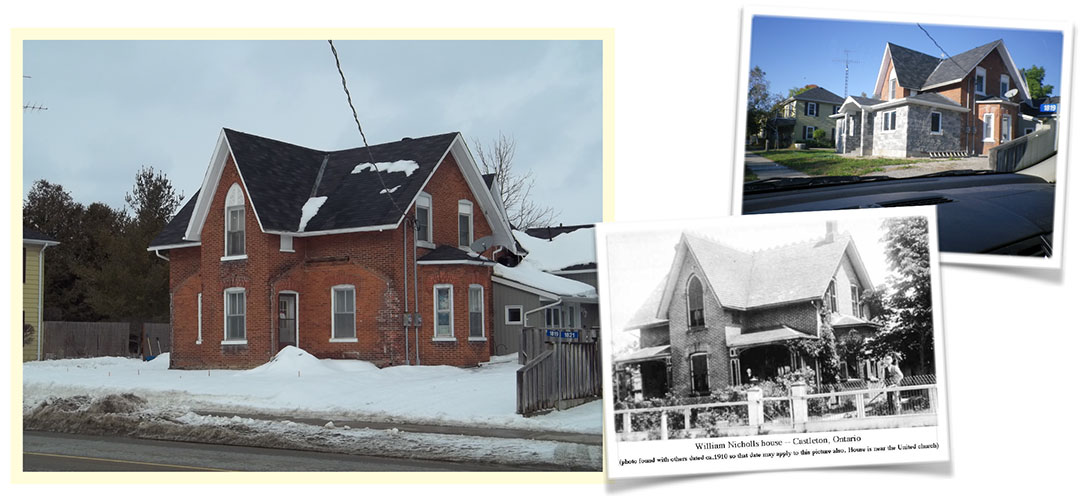1819 Percy Street, Castleton
(c.)
Roll No. – Cramahe Township Ontario

Gothic Revival Farmhouse
The William Nicholls house was probably built around the turn of the 20th century. As the vintage picture above shows, it was one of the substantial homes on Castletown’s main street adjacent to the United Church. (see the history and appearance of 1804 Percy Street, Castleton across the street).
Like many Victorian houses, it is an amalgam of architectural styles with its steep Gothic gables, two story front entrance extrusion with the entrance door in the side rather than the front, and a Palladian window in the second story. The house had a double verandah on the front facade with decorative pillars painted in contrasting colours (a nod to the Victorian Painted Ladies). The verandah, as well as being functional, added style and mass to the front facade. The house has a single story three pane bow window on the right side, two over two window panes and a cross gabled roof. The decorative fret work across both gables of the original house evident in the old picture no longer exists.
The modern day house has an rear addition which does not appear to be there in the vintage picture.
100 years ago, this house was resplendent in its Northumberland red brick, draped with ivy and behind a somewhat unique front fence and gate that, along with the hedges, charmingly framed the building.
History or Associative Value
In a coincidence that begs more explanation, this house is called the William Nicholls House in archival records. (see reference in the above vintage picture) However, research shows that William’s name was in fact “Nichols” and the only “Nicholls” associated with this house was the wife of a previous owner. The Nichols family owned the property from 1872 to 1944, a 72 year span that would logically earn the right to name the house.
Additional Historical and Genealogical Information
1819 Percy Street, Castleton, Ontario
Cramahe Township, Concession 7, Lot 33, Castleton Lot 13
The 200 acres of Lot 33, Concession 7, which includes much of modern-day Castleton, were granted by the Crown to Catherine Williamson (1800-1879), Martha Byrns (1797-1870), Sarah Stevens (1794=?), Rebecca Pruyn (1809-?), and Jane Pruyn (1798-?) on 2 April 1832. These were the five daughters of Matthew Pruyn (1762-1813) an Empire Loyalist who settled in Prince Edward County. It is unclear why his daughters were granted this land. There is no evidence that any of them ever lived there.
Rebecca Pruyn sold the 200 acres belonging to herself and her sisters to Joseph Abbott Keeler (1788-1855) on 23 February 1833. Over the next several years Keeler sold of bits and pieces of this land, and what was left went to his son Joseph Keeler (1824-1881) on 23 September 1854.
Hugh Mills Bunbury (1833-1902) purchased Castleton Lot 12 from Joseph Keeler on 22 October 1859. Bunbury was a miller, married to Adelaide (“Adda”) Cole ( 1842-1910) and had two children: Anna (1858-?) and Hugh (1860-?).
Less than a month later, on 16 November 1859, Bunbury sold the property to John Hillaird Cameron (1817-1877) of Toronto, Asa Allworth Burnham (1808-1873), James Cockburn (1819-1883), and Henry Covert (1815-1893) of Cobourg. These gentlemen were “trustees of the marriage settlement of the late S. E. MacKechnie and wife”. Cameron was a Solicitor and would soon become Chancellor of Trinity College. Burnham was a member of the Legislative Council of the Province of Canada and would later be mayor of Cobourg and a Senator. Cockburn was another lawyer and member of the Legislative Assembly; he was the first Speaker of the House of Commons following Confederation in 1867. Covert was the president of the Cobourg and Peterborough Railway. Stuart Easton MacKechnie (1816-1853) was a prominent Cobourg industrialist, farmer, and another mayor of Cobourg. His wife was Anna Maria Barbara Poore (1824-1899). This transaction is rather obscure. What was the connection between Bunbury and MacKechnie? Why would the trustees of a marriage settlement purchase property 11 years after that marriage took place and six years after the bridegroom was dead?
In any case, Cameron, Burnham, Cockburn, and Covert sold Lot 13 back to Bunbury on 31 July 1866. A year later (29 July 1867), Bunbury and his wife sold it to Nelson Ingersoll (1819-1887). Ingersoll was married to Jane Nicholls (1815-1883) and had five children: Elijah (1838-?), Emma Jane (1846-?), Albert Alonzo (1849-1900), Sarah A. (1851-?), and Nelson F. (1858-?). Ingersoll was a blacksmith.
On 4 August 1872 Ingersoll and his son Nelson (a telegraph operator) sold the property to William Nichols (1844-1923), another blacksmith. It would be tempting to hypothesize that William Nichols was related somehow to Nelson Ingersoll’s wife Jane Nicholls, but no connection has yet been found.
The property remained in the hands of the Nichols family until 1944.
Hugh Bunbury purchased Lot 13 in 1859 for £70 and 10 shillings and sold it a month later to Cameron et al. for £100. Bunbury got it back in 1866 for 5 shillings. He sold it to Nelson Ingersoll in 1867 for $300 and Ingersoll sold it to Nichols in 1872 for $400. Since £70 and 10 shillings was equivalent to $282, none of these values indicate a clear improvement to the property, so they provide no information as to the possible construction date of the house.
Castleton, ON K0K 1M0, Canada
